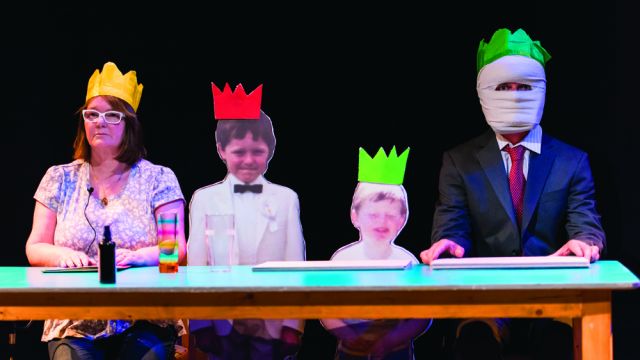Have I No Mouth
On the way in, we are handed empty balloons. The show begins. Dr Erich Keller, psychiatrist, playing Dr Erich Keller, psychiatrist, puts us through a relaxation exercise. We are told to breathe in through the nose, out through the mouth, and feet flat on the floor. Whether this is simply good for us or to make us more receptive to the show isn’t clear. Later, he asks us to inflate our balloons by blowing our anger into them.
These soft-spoken, oh-so-benign instructions feel rather presumptuous and annoying. But we’re Australians – polite and cooperative – so we blow up the balloons, although we’re indulging Dr Keller and it’s more to see what he will ask us to do next. On stage, a balloon held by one of the actors (Feidlim Cannon playing Feidlim Cannon) is popped with a scalpel. Dr Keller asks us not to do that, but to release our ‘anger’ slowly. We do. The squeal of escaping air goes on for some time, accompanied by uncertain laughter.
Yes, there is a sort of a point to this, but it’s just one of the skewed, not quite convincing metaphors or symbols that make up too much of this play. A couple of times later, for instance, Dr Keller climbs on a chair and sprinkles ‘snow’ from a kitchen strainer onto Feidlim or his mother, Ann Cannon (played by Ann Cannon). I’m not sure why, unless it was actually snowing when these moments occurred in ‘real life’ because all events enacted or narrated here occurred in real life. Since Ms Cannon is the real Ms Cannon we must accept that, really, she cannot act – or she is acting someone real and therefore acts as someone who cannot act.
Later, Dr Keller becomes Sean, Feidlim’s dead father. For this he wears a boxing helmet and then swathes it and his head in a bandage until only his eyes are visible. Is this dead Sean bandaged after his fatal operation? Or dead Sean as a corpse? Or dead Sean masked and inaccessible because there is no communication with the dead?
Have I No Mouth is based on Ann Cannon and Feidlim Cannon’s real life experiences and their therapy sessions with the real Dr Keller. It is therefore ‘true’ and involves real experiences of grief, pain and anger. Twenty-nine years ago, when Feidlim was seven, Ann had ‘Baby Sean’, who died after fifteen days. She is still grieving, although she is a devout Catholic and she has developed ways of remembering. Twelve years ago, her husband and Feidlim’s father, Sean, died after a grievous misdiagnosis led to a botched operation. Feldlim’s initial protestations to the contrary, he is still grieving and worse, angry that his father died – and after promising one Christmas that he would never die.
The literal truths of this presentation have meant that some have found it very moving. The nature of the truths may inhibit some people from questioning their presentation and lead to a charge of heartlessness against those who do. All the same, my adage is, ‘true isn’t good enough’. The show sets out to be sincere and artless – and Mr Cannon and Mr Keegan, the writers, may be sincere in giving us this artless presentation. But, via being ‘true’, the show ends up appearing half-baked, a workshop production and, whatever the intention, actually quite manipulative. Well, all art is manipulative, but Have I No Mouth keeps reminding you of the fact by pointing to its sincerity.
The stage is almost bare. There is a screen on which Feidlim projects a video tribute to his father. It’s pretty bad and tells us almost nothing about the father, but Feidlim hastens to tell us that it is bad. The Baby Sean is represented by a doll. Seven-year-old Feidlim is represented by a life-size cutout, as is his younger brother Padraic. The dining table is also an operating table. The appropriately period telephone on which Feidlim gets the news of his father’s death stands alone at one side of the stage. And so on.
Nevertheless, there are moments when the audience is pulled in closer and is made to feel something. When Ann makes the boy Feidlim recite the road safety and stranger danger rules, clearly she loves him and seeks to protect him. But she cannot protect him from death. Strangely, it is one of the most bizarre or ‘symbolic’ sequences, toward the end, that is the most powerful of the whole show. Feidlim, in his Christmas paper crown (from the Christmas when Sean said he would never die) attaches a soccer ball on a short cable to silent, Dead Sean and makes him kick it. The ball just flips over Dead Sean’s back. Daddy can’t play. Daddy will never play now. Feidlim becomes angrier and angrier. He attacks Dead Sean. He wrestles him to the ground. Here the rage and grief are palpable.
Much of the time, however, the proceedings are so measured, so restrained that I felt held at a distance and un-moved. At the very end, hundreds of coloured balloons are released onto the audience and the stage. The cast is now smiling, so this is a good thing – or is it? Are these balloons filled with someone’s anger? Whichever, it is not a finale earned by what precedes it.
Michael Brindley
Subscribe to our E-Newsletter, buy our latest print edition or find a Performing Arts book at Book Nook.

